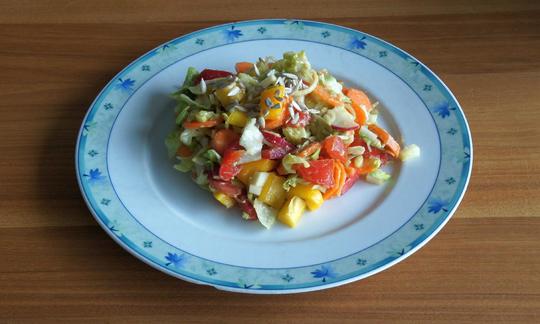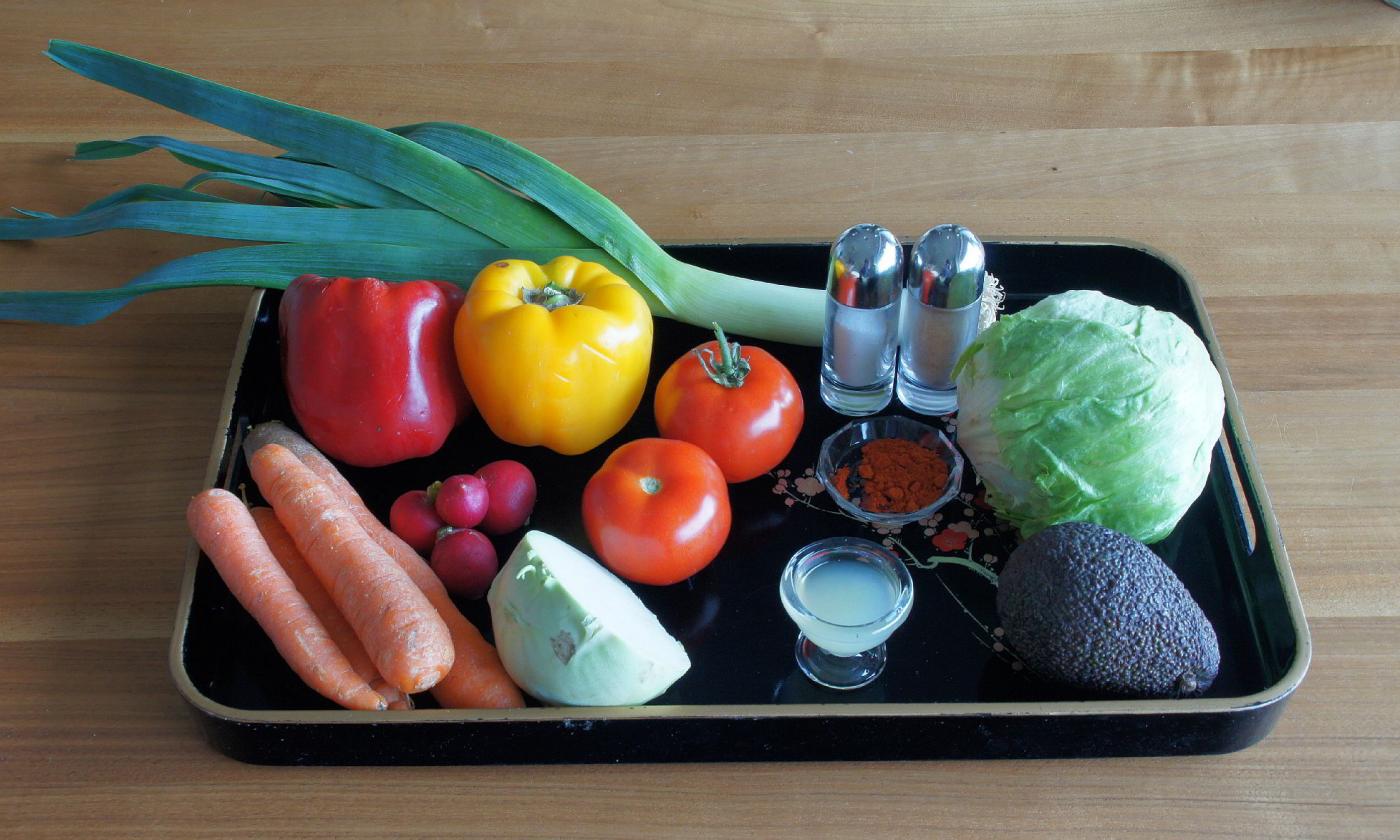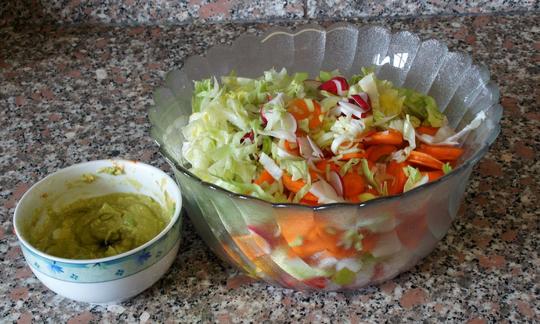raw vegetable salad with avocado-lemon dressing
raw-vegan
Ingredients (for servings, )
| For the raw vegetable salad | |
|---|---|
| 4 | Carrots (carrots), raw (organic?) (8.6 oz) |
| ½ | Kohlrabi, raw (organic?) (6.2 oz) |
| 3 stalks, cleaned | Leek, raw (organic?) (9.4 oz) |
| ½ | Iceberg lettuce (crisphead group), raw, organic? (9.5 oz) |
| 2 | Tomatoes, raw (organic?) (8.6 oz) |
| 4 | Radishes, raw (organic?) (0.63 oz) |
| 1 | Sweet pepper, yellow, raw (organic?) (5.5 oz) |
| 1 | Sweet peppers, red, raw (organic?) (5.8 oz) |
| For the avocado-lemon dressing | |
| 1 | Avocados, raw (organic?) (7.1 oz) |
| 2 tbsp | Lemon juice (raw?, organic?) (0.51 oz) |
| 1 tsp | Agave syrup (agave syrup, raw?, organic?) (0.24 oz) |
| ½ tsp | Paprika powder, hot (raw?, organic?) (0.04 oz) |
| 1 dash | Table salt (table salt, raw?, organic?) (0.01 oz) |
| 1 dash | Black pepper (organic?, raw?) (0.00 oz) |
| For the garnish | |
| ½ cup | Sunflower seeds, raw (organic?) (2.5 oz) |
Equipment
- hand-held blender / immersion blender or blender
- vegetable peeler
Type of preparation
- chop or grind
- food preparation without heating
- blend
- peel
Preparation
For the raw vegetable salad
Peel the carrots with a vegetable peeler and the kohlrabi with a knife.If you don't feel confident using a knife, you can also peel the kohlrabi with a vegetable peeler.
Wash the leeks, iceberg lettuce, tomatoes, radishes and peppers well.
Cut all vegetables into any size and place in a large bowl.
The leek should be cut as finely and small as possible so that it tastes more pleasant in the salad.
For the avocado-lemon dressing
Cut the avocado crosswise, remove the stone and put the flesh in a bowl with lemon juice, agave syrup, paprika powder, salt and pepper. Use a hand blender to process the mixture into a liquid paste.Pour the avocado-lemon dressing over the vegetables in the large bowl and mix well.
Garnish and serve
Arrange the "raw vegetable salad with avocado-lemon dressing" on a flat plate and garnish with sunflower seeds.
|
Nutritional Information per person
Convert per 100g
|
2000 kcal | |
|---|---|---|
| Energy | 249 kcal | 12.5% |
| Fat/Lipids | 14 g | 19.7% |
| Saturated Fats | 1.6 g | 7.9% |
| Carbohydrates (inc.dietary fiber) | 30 g | 11.0% |
| Sugars | 11 g | 12.0% |
| Fiber | 9.9 g | 39.4% |
| Protein/Albumin | 7.2 g | 14.4% |
| Cooking Salt (Na:97.9 mg) | 249 mg | 10.4% |
| Essential micronutrients with the highest proportions | per person | 2000 kcal | |
|---|---|---|---|
| Vit | Vitamin C (ascorbic acid) | 145 mg | 181.0% |
| Vit | Vitamin B9, B11 (Folate, as the active form of folic acid) | 162 µg | 81.0% |
| Vit | Vitamin K | 59 µg | 79.0% |
| Vit | Vitamin A, as RAE | 550 µg | 69.0% |
| Vit | Vitamin E, as a-TEs | 7.7 mg | 64.0% |
| Min | Copper, Cu | 0.55 mg | 55.0% |
| Vit | Vitamin B6 (pyridoxine) | 0.76 mg | 54.0% |
| Elem | Potassium, K | 1'006 mg | 50.0% |
| Min | Manganese, Mn | 0.91 mg | 46.0% |
| Fat | Linoleic acid; LA; 18:2 omega-6 | 4.1 g | 41.0% |
Detailed Nutritional Information per Person for this Recipe
The majority of the nutritional information comes from the USDA (US Department of Agriculture). This means that the information for natural products is often incomplete or only given within broader categories, whereas in most cases products made from these have more complete information displayed.
If we take flaxseed, for example, the important essential amino acid ALA (omega-3) is only included in an overarching category whereas for flaxseed oil ALA is listed specifically. In time, we will be able to change this, but it will require a lot of work. An “i” appears behind ingredients that have been adjusted and an explanation appears when you hover over this symbol.
For Erb Muesli, the original calculations resulted in 48 % of the daily requirement of ALA — but with the correction, we see that the muesli actually covers >100 % of the necessary recommendation for the omega-3 fatty acid ALA. Our goal is to eventually be able to compare the nutritional value of our recipes with those that are used in conventional western lifestyles.
| Essential fatty acids | per person | 2000 kcal |
|---|---|---|
| Linoleic acid; LA; 18:2 omega-6 | 4.1 g | 41.0% |
| Alpha-Linolenic acid; ALA; 18:3 omega-3 | 0.16 g | 8.0% |
| Essential amino acids | per person | 2000 kcal |
|---|---|---|
| Threonine (Thr, T, irreversibly transaminated) | 0.36 g | 38.0% |
| Tryptophan (Trp, W) | 0.09 g | 37.0% |
| Isoleucine (Ile, I) | 0.32 g | 26.0% |
| Valin (Val, V) | 0.36 g | 22.0% |
| Phenylalanine (Phe, F) | 0.33 g | 21.0% |
| Leucine (Leu, L) | 0.47 g | 20.0% |
| Lysine (Lys, K, irreversibly transaminated) | 0.35 g | 19.0% |
| Methionine (Met, M) | 0.12 g | 13.0% |
| Vitamins | per person | 2000 kcal |
|---|---|---|
| Vitamin C (ascorbic acid) | 145 mg | 181.0% |
| Vitamin B9, B11 (Folate, as the active form of folic acid) | 162 µg | 81.0% |
| Vitamin K | 59 µg | 79.0% |
| Vitamin A, as RAE | 550 µg | 69.0% |
| Vitamin E, as a-TEs | 7.7 mg | 64.0% |
| Vitamin B6 (pyridoxine) | 0.76 mg | 54.0% |
| Vitamin B1 (Thiamine) | 0.39 mg | 35.0% |
| Vitamin B7 (Biotin, ex vitamin H) | 13 µg | 26.0% |
| Vitamin B3 (Niacin) | 3.7 mg | 23.0% |
| Vitamin B5 (Pantothenic acid) | 1.2 mg | 21.0% |
| Vitamin B2 (Riboflavin) | 0.22 mg | 16.0% |
| Essential macroelements (macronutrients) | per person | 2000 kcal |
|---|---|---|
| Potassium, K | 1'006 mg | 50.0% |
| Phosphorus, P | 206 mg | 29.0% |
| Magnesium, Mg | 103 mg | 27.0% |
| Calcium, Ca | 94 mg | 12.0% |
| Sodium, Na | 98 mg | 12.0% |
| Essential trace elements (micronutrients) | per person | 2000 kcal |
|---|---|---|
| Copper, Cu | 0.55 mg | 55.0% |
| Manganese, Mn | 0.91 mg | 46.0% |
| Iron, Fe | 3.1 mg | 22.0% |
| Selenium, Se | 8.7 µg | 16.0% |
| Zinc, Zn | 1.5 mg | 15.0% |
| Iod, I (Jod, J) | 2.9 µg | 2.0% |
| Fluorine, F | 5.7 µg | < 0.1% |
Raw vegetable salad with avocado and lemon dressing tastes fresh and delicious. It is not only a refreshing dish, but is also rich in fiber.
Agave syrup: Agave syrup is a natural sweetener obtained from agaves. Raw agave syrup is thick and has a neutral taste. It is more sweet than sugar and is easily soluble in both cold and warm substances. Since agave syrup is mainly composed of fructose and glucose, with the former predominating, agave syrup has a very low glycemic index compared to other sweeteners. However, it should not be forgotten that a high fructose content can also have negative effects. You can find out more about this in the relevant ingredient text. For optimal storage, the syrup should be kept at a temperature below 14 ° C and a humidity of less than 65%.
Fiber: This easily digestible raw vegetable salad is relatively low in calories, but contains a high proportion of fiber, which is beneficial for digestion. Fiber is mainly found in plant-based foods and is indigestible for the human body due to its composition. This increases the volume of food and leads to an increase in the feeling of satiety, but without affecting the energy content. It also ensures that the absorption of carbohydrates in the intestines is slower, which has a positive effect on the rise in blood sugar. Since certain fibers, such as psyllium husks, bind a lot of water, it is advisable to drink enough to avoid fiber-induced constipation.
Kohlrabi: Kohlrabi is one of the many cultivated forms of cabbage. There are basically two forms, which can be distinguished by color and growing time: green-white and blue-violet kohlrabi. The flesh of both varieties is greenish in color. There are no noticeable differences in taste. Both varieties taste slightly sweet, with apple and citric acid dominating. When buying, make sure that the fresh bulb has no cracks. Kohlrabi can be stored in the vegetable compartment of the refrigerator for around a week.
Paprika powder: Paprika powder is available in a wide range of spiciness levels. In our latitudes, it is divided into delicatessen paprika (mild), noble sweet (spicy and mild), semi-sweet (quite spicy) and rose paprika (spicy). Depending on the country, other spiciness or taste levels are also available. As a rule, an increased level of spiciness correlates with a decreasing intensity of the red color of the powder.
Using kohlrabi leaves: You should never throw away the kohlrabi leaves when buying organic vegetables. They can be prepared like leafy vegetables, such as spinach, and contain around twice as much vitamin C as the actual tuber and almost 100 times as much carotene.
Use dark green parts of the leek: Many people avoid using the dark green leek tips because they have a tougher texture and a more bitter taste than the other parts of the leek. However, with organically grown leeks you can really use the whole leek. If you can't get these parts raw, you can steam them or use them in the form of a soup.
Avocado: If the avocado is soft enough, you can mash the avocado with a fork and mix it with the dressing ingredients instead of using a hand blender. Depending on your preference, you can also make a slightly grainier dressing this way.
Type of lettuce: Depending on your taste, you can also use other types of lettuce such as lettuce or endive. In the latter case, you can increase the amount of agave syrup if you do not like the bitterness of the endive.
Nuts: Add several chopped nuts to taste, such as Brazil nuts or macadamia nuts.










